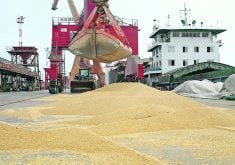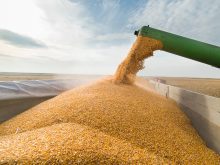Hope and skepticism are greeting the Winnipeg Commodity Exchange’s
decision to develop an edible peas futures contract to replace the
failed field peas contract.
A new contract will have to be well designed and able to sway an
industry comfortable with cash markets.
“We would use it,” said Anthony Kulbacki of Blue Hills Processors Ltd.
in Avonlea, Sask.
“There’s no effective hedging mechanism right now.”
Kulbacki, whose company is building a pulse processing plant, said a
Read Also

Trump’s tariffs take their toll on U.S. producers
U.S. farmers say Trump’s tariffs have been devastating for growers in that country.
simple hedging device such as a futures contract would help the
industry grow by reducing the risk faced by farmers, processors and
buyers.
Scott Cunningham, president of the Canadian Special Crops Association,
agreed.
“I think everyone in the industry would be very interested in any new
hedging or risk management tool,” Cunningham said.
If a viable peas contract could be established, it might open the door
to futures contracts in other special crops, such as lentils and
canaryseed.
But Brian Clancey of Stat Market Research said the exchange’s three
failed attempts at building a pea contract do not augur well for
another revision.
“Clearly the people in this industry haven’t wanted it and haven’t
needed it,” said Clancey.
“Without the participation of the industry and farmers, you’re just not
going to have the liquidity that’s going to attract the speculative
interest that’s going to allow this thing to go.”
The exchange delisted its stagnant field peas contract Oct. 15, but has
already begun looking into whether a contract focused on human
consumption peas would work better than the former contract, which was
based on peas for livestock feed.
“The conversations with the industry have already begun,” said exchange
economist Lyndon Peters.
The field pea contract was introduced in November 1995, when prairie
production of field peas was rapidly expanding. The biggest buyers were
European, so it was designed to hedge feed peas produced outside of
Europe but delivered to European ports.
Some companies used the contract, but others began using it in an
unintended way to force pea deliveries, Clancey said. But speculators,
who add necessary liquidity to any contract, avoided the contract
because they didn’t want to be forced to deliver a commodity.
The contract was redesigned twice to make it more usable, but volume
sputtered and died.
The field pea contract wasn’t restricted to feed peas, but Clancey said
edible pea marketers did not use it, so it became a feed pea contract.
Feed pea production collapsed on the Prairies as drought struck some of
the biggest production areas in 2001 and 2002 and that skewed the
industry toward edible peas.
Peters said the exchange talked with the Canadian special crops
industry, and most players were more interested in an edible pea
contract rather than a feed pea contract, since that’s where most
companies and producers have turned their attention.
“The edible pea market has been the driving force behind the industry,”
Peters said.
But Clancey thinks the pea industry may swing back toward feed
production as western prairie acreage recovers from drought, especially
if anything affects demand from India for edible peas.
“The reason we think edible peas are so hot is that India is buying so
much,” said Clancey.
“But Indian demand cannot be guaranteed.”
India is encouraging domestic production, and nearby countries such as
China and Burma are ramping up production to try to take Canada’s
place.
Europeans may also figure out that edible peas pay premiums and begin
pursuing the Indian market, Clancey said. Europe harvests earlier than
Canada and would be able to fill early markets.
Clancey said he believes India will continue to be a market, but its
demand won’t be enough to make prairie peas a primarily human food.
“Within two years we could be back to having feed peas a 1.5 million
tonne industry and India could go back to being a sporadic buyer,” said
Clancey.
Another challenge for an edible pea contract is the special crops
industry’s well developed cash contracting system, which operates as a
form of hedging. Special crops marketers are familiar with forward
contracts between growers, processors and end users.
They won’t use a futures contract if it doesn’t offer much more
security than the present system.
“You have to convince them that what you are doing is adding value,”
said Clancey.
Peters said members of the Canadian special crops industry have told
the exchange they want to have futures contracts to manage their risk.
Their chance to prove all parts of the industry want it will come in
the next few months, as the exchange attempts to finally make peas work
in a futures contract.















